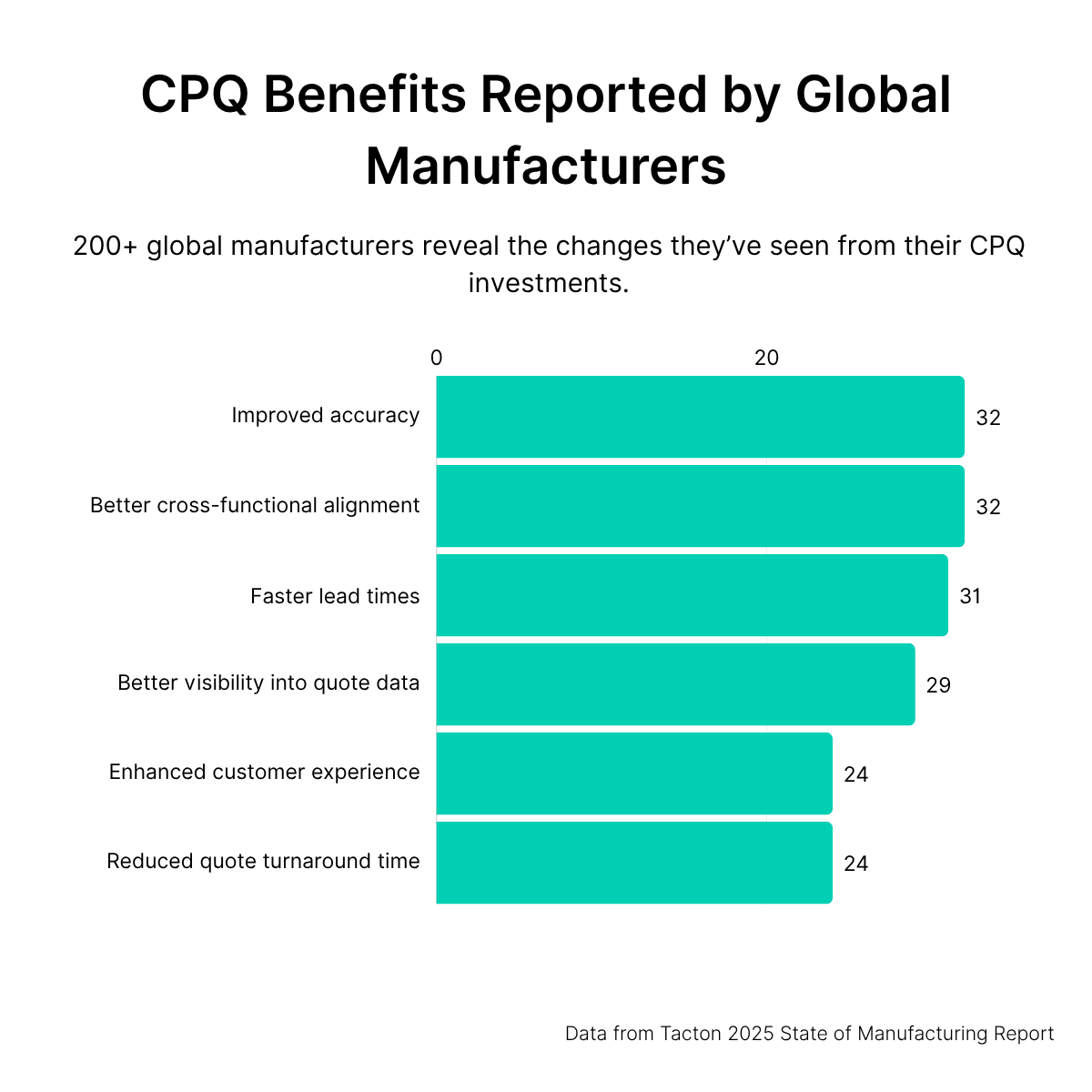What Is CPQ for Manufacturing? A Complete Guide
The first one to solve a prospect’s problem becomes the partner of choice. If you’re wrestling with pricing and product SKUs in multiple places, if quoting takes weeks of technical validation, or if you’re reworking and adjusting quotes consistently, then you’re losing potential business.

The first one to solve a prospect’s problem becomes the partner of choice. If you’re wrestling with pricing and product SKUs in multiple places, if quoting takes weeks of technical validation, or if you’re reworking and adjusting quotes consistently, then you’re losing potential business.
Configure, Price, Quote (CPQ) software helps manufacturers generate fast, accurate, and error-free quotes for complex, configurable products without consistent engineering input. It connects product data, pricing logic, and customer-facing tools to accelerate sales and simplify even the most customized orders.
The data confirms that quoting can be an error-riddled process. According to our 2025 State of Manufacturing Report,, 79% of manufacturers experience issues with quote quality, and four in 10 are still quoting manually. As a result, many manufacturers are looking for a better way to quote—with CPQ software.
This beginner’s guide breaks it down: what CPQ stands for, how it works for manufacturers, and why it has become a critical tool for companies looking to modernize their sales process.
What does CPQ stand for? Configure, price, quote explained
CPQ stands for configure, price, quote. It’s a category of software designed to help businesses generate fast, accurate quotes for configurable products without constant intervention from engineering or manual workarounds.
- Configure: It guides sales teams (and often end customers) through selecting the right options, components, and features based on product rules, compatibility constraints, and technical feasibility.
- Price: It calculates accurate pricing automatically based on configuration, quantities, regional pricing, bundled services, and discounting rules.
- Quote: It generates a professional proposal that reflects the full configuration and pricing that’s ready for a customer in minutes, not days.
Some ERP or CRM platforms offer quoting software, but they’re rarely built for the complexity that manufacturers face. Standard modules often fall short when products have thousands of potential combinations or when pricing depends on engineering validations and regional requirements. CPQ systems are purpose-built for environments where thousands of potential combinations, engineering constraints, and evolving pricing models are the norm.
What is CPQ for manufacturing?
Manufacturing introduces a level of complexity that general-purpose CPQ systems simply aren’t built to handle. Whether you’re producing turbines, surgical trays, or pump and valve assemblies, your products likely come with thousands of configuration possibilities, and each must be technically valid, manufacturable, and priced correctly.
Modern CPQ software built for manufacturing guides sellers and buyers through configuration and also enforces engineering constraints, validates configurations in real time, and ensures that what gets quoted can actually be built. This includes support for complex Bills of Materials (BOMs), which are automatically generated based on product configurations to ensure seamless downstream integration with engineering, production, and ERP systems.
CPQ systems designed for manufacturers also support:
- Dynamic pricing models including volume discounts, bundled services, aftermarket and service pricing, regional pricing, and special terms
- Integration with PLM, ERP, and CAD to keep product data and pricing synchronized across systems
- 3D and augmented reality (AR) visualization allowing internal teams or end customers to see product configurations in real time
- Partner and reseller workflows enabling dealer networks to configure and quote accurately without compromising product or pricing rules
- Self-service capabilities empowering buyers to configure and request quotes directly through digital channels, speeding up response time and reducing sales friction
- Sustainability tools presenting the carbon footprint of solutions to optimize for customers’ sustainability needs
- Analytics providing deal data and customer behavior data to help you identify profitable designs and learn what deals are more likely to win
With CPQ, manufacturers can ensure that every quote is accurate, buildable, and delivered faster, whether it’s generated by an internal sales rep, a partner, or the end customer themselves.
Who uses CPQ software across the enterprise?
CPQ has traditionally been a back-end tool used to build and price solutions behind the scenes. But, much more than that, it’s a strategic, frontline system that connects engineering, sales, IT, and even the customer. The result: faster, more accurate quotes that align teams and build trust with customers.
Roles that benefit:
- IT and digital transformation leaders who lead CPQ initiatives, own integrations, and ensure systems scale across global teams
- Sales and revenue leaders who rely on CPQ to boost sales efficiency, reduce manual work, and support reps in quoting without complete reliance on technical teams
- Sales engineers who spend less time validating quotes and more time on strategic solutions
- Channel partners, distributors, or resellers who can quote accurately and independently with pre-set rules and configuration tools within the OEM’s CPQ
- Engineering and product leaders who trust CPQ to enforce complex product logic and support faster innovation
- CPQ managers and solution owners who evaluate systems and ensure adoption across teams
- Executive leadership who use CPQ to drive digital transformation, customer-centric growth, and long-term scalability
Common challenges solved by CPQ software
CPQ software helps resolve the friction and inefficiencies found in traditional manufacturing sales of products with hundreds or thousands of variations:
- Slow quote cycles: Replace multi-week quoting processes with real-time, automated tools
- Sales-engineering bottlenecks: Reduce the need for engineering approvals on every quote
- Quote errors and rework: Prevent invalid configurations and manual pricing mistakes
- Pricing inconsistencies: Enforce pricing rules across global regions and sales channels and avoid over-discounting with automated margin control
- Outdated or manual quoting: Eliminate reliance on spreadsheets, email-based quoting, and wading through multiple systems to respond to an RFQ
Top benefits of CPQ software: Is CPQ worth it for your business?
CPQ software helps sales, engineering, and operations teams eliminate bottlenecks in the quoting process, which drives better business outcomes across the board. Here are just a few of the benefits manufacturers see when they implement CPQ systems:
- Faster quote turnaround: Quotes that once took days or weeks can now be done in minutes, allowing your team to respond to customers before the competition does.
- Fewer errors and rework: By embedding product and pricing rules into the quoting process, CPQ helps eliminate misconfigurations, manual pricing mistakes, and unnecessary back-and-forth with engineering.
- Reduced sales dependency on engineering: Teams spend less time chasing approvals and more time closing deals, freeing up engineering resources for higher-value work.
- Consistent, scalable pricing: Whether you’re quoting in North America, Europe, or Asia, CPQ ensures pricing logic is enforced across markets, dealers, and sales teams.
- Improved customer experience: Faster, more accurate quotes lead to smoother sales conversations and increased buyer confidence.
Examples of CPQ in manufacturing
These benefits aren’t just theoretical. Take Siemens Energy as an example. Before implementing CPQ, it took their team up to eight weeks to generate a customer quote, often requiring deep engineering involvement and manual effort. After adopting Tacton CPQ, Siemens reduced quote generation time from eight weeks to minutes.
Siemens isn’t alone. Manufacturers like Spectrum Industries have seen an 50% increase in quoting efficiency, while companies like Bromma have improved lead times and supplier relationships with CPQ integration. Our State of Manufacturing report also finds that the top benefits among over 200 global manufacturers include improved selling precision and greater alignment between commercial and technical or production teams.
CPQ vs. ERP vs. CRM tools for quoting
You may be thinking, “We already quote through our ERP or CRM.” Though those tools may cover basic quoting needs, they weren’t designed for your complex manufacturing needs.
- ERP is typically rigid and backend-focused. They’re great for tracking inventory and managing orders, but they aren’t built to handle real-time product configuration or customer interaction. Most ERP systems lack the flexibility to guide users through compatibility rules or enforce technical constraints during quoting.
- CRM as a buyer engagement tool often falls short because, it stops at the surface. While they’re useful for managing relationships and pipeline data, they typically don’t have the depth to support complex pricing logic, engineering rules, or manufacturing feasibility.
Excel or manual quoting is surprisingly common, but it’s also the most vulnerable. Quotes built on spreadsheets and email chains are prone to version control issues, delays, and costly errors.
That’s where CPQ software makes a major difference. It enhances and works with your ERP or CRM to centralize critical data. CPQ connects your CRM’s front-end sales process with the ERP’s backend fulfillment and manufacturing systems.
How to know if CPQ is right for your business
Still unsure whether CPQ is the right fit for your organization? If any of the following statements sound familiar, then it might be time to consider a CPQ solution built for manufacturers:
- If your quotes are frequently reworked due to errors, missed requirements, or miscommunications
- If you’re losing customers to competitors due to slow responsiveness
- If your sales team spends more time quoting than actually selling
- If launching a new product means long delays updating your quoting tools
- If you don’t have a way for buyers to easily explore your product on their own terms
- If you’re expanding into new regions or markets
- If each quote requires tribal knowledge or you expect that your veteran technical experts and sellers will be retiring soon
- If partners or resellers struggle to quote without your support
- If you can’t easily see which quotes are winning, losing, or stalling
- If sustainability or compliance is increasingly important in your industry
Types of CPQ software
When choosing a CPQ solution, it’s helpful to understand the types of systems available:
- Embedded/Platform-based CPQ: Basic functionality is often embedded in CRM or ERP systems, and CPQ is part of a larger portfolio of software products. These tend to have limited configuration or pricing flexibility.
- Standalone, industry-specific CPQ: Built for the needs of manufacturers, these systems support complex product logic, CAD/PLM integration, and regional pricing.
- Cloud-based CPQ vs. on-prem CPQ: Modern CPQ platforms are web-based, but companies with certain restrictions and legacy tools may use an on-premise tool.
- AI-powered CPQ: Next-gen CPQ software uses machine learning and other intelligent tools to suggest optimal configurations, pricing strategies, or quote content based on historical data and customer behavior.
How to get started with CPQ software for manufacturing
Before diving into demos or feature comparisons, take a step back and start with your quoting process.
- Focus on your biggest quoting challenges. Where are the delays happening? What’s causing the most friction between sales and engineering? Which quotes tend to require the most back-and-forth? Identifying these bottlenecks will help you define your goals and prioritize what matters most.
- Include all stakeholders in the evaluation process to align on needs. Successful CPQ projects involve input from sales, engineering, IT, and operations. Each team brings a unique perspective, and collaboration is crucial to ensuring the solution fits both technical needs and business goals.
- Zero in on your most complex or error-prone products. You don’t need to transform your entire catalog overnight. Start with one product line or region where CPQ can make an immediate impact and scale from there.
- Choose a CPQ platform built for your complexity. Not all CPQ systems are created equal. Look for a solution that handles engineering rules, supports integration with your ERP and PLM systems, and offers guided selling for non-technical users.
By starting with your pain points and involving the right people, you can set your CPQ initiative up for long-term success.
Why manufacturers choose Tacton
For manufacturers with complex, configurable products, not just any CPQ will do. Tacton CPQ is made for the specific demands of industrial and engineer-to-order environments, where quoting accuracy, speed, and product feasibility are mission-critical.
Tacton brings decades of experience working with global leaders in medtech, industrial machinery, heavy vehicles, and more, helping them simplify complexity while improving the way they sell. Unlike generic CPQ platforms, Tacton was designed from the ground up to handle engineering rules, system integration, and highly customized pricing models, all without compromising speed or user experience.
Tacton also transforms the buying experience, empowering customers and sales teams with guided selling tools that make even the most complex products easy to understand, configure, and quote. These benefits are why we’ve been recognized as a Leader in the Gartner® Magic Quadrant™ for CPQ Applications, underscoring our commitment to innovation and excellence in the manufacturing space.
Ready to see what CPQ can do for your business?



